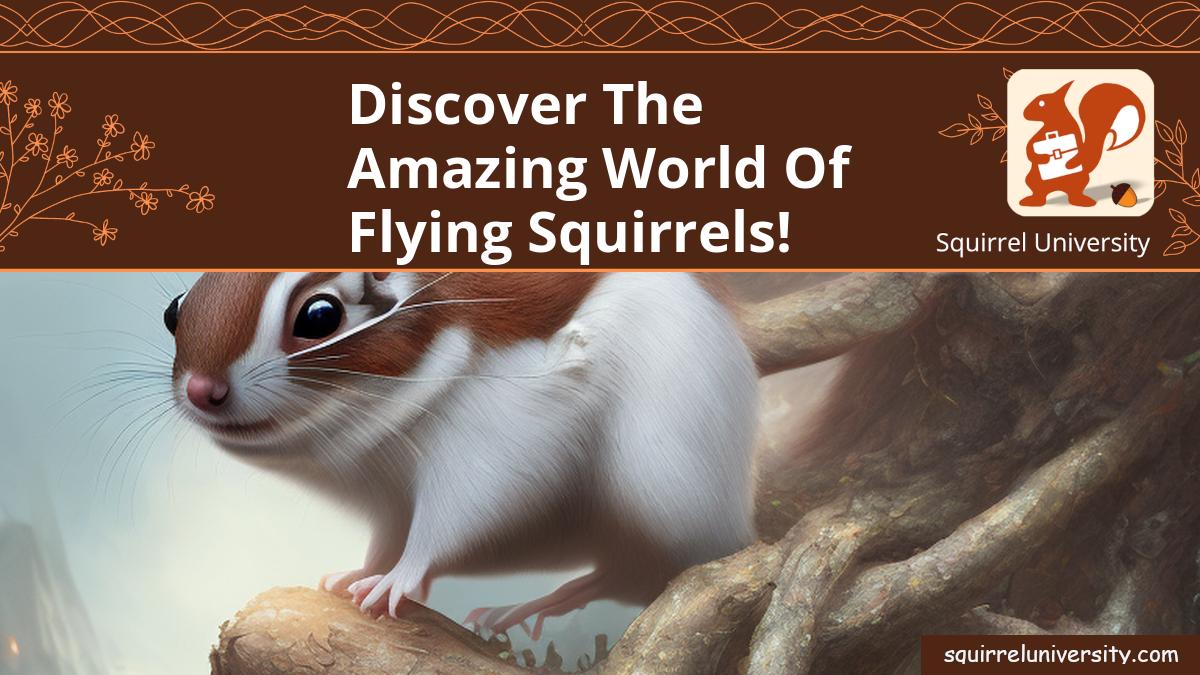As a passionate nature lover with years of experience in observing and interacting with flying squirrels, I am excited to share the amazing world of these remarkable creatures! Flying squirrels are incredible animals, but unfortunately their two subspecies on the federal endangered species list are threatened by habitat loss. In this blog post, let’s explore their habitats and discover the unique abilities of these magnificent animals.
The two subspecies of northern flying squirrels that are on the federal endangered species list are threatened by habitat loss. Flying squirrels typically inhabit mature coniferous and hardwood forests; the reduction or elimination of these habitats has led to their population decline in some regions.
Flying Squirrels: An Amazing Species
When one thinks of flying squirrels, they might think of the cute and cuddly rodents they have seen bouncing around on cartoons. But in reality, these aerial mammals are true marvels of aerodynamic mastery! Flying squirrels are a complex species with an array of distinct physical adaptations and behaviors that set them apart from other species.
What Are Flying Squirrels?
Flying squirrels belong to the scientific order of Rodentia and family Sciuridae, which includes all members of the rodent family such as chipmunks and ground squirrels. They are typically nocturnal birds and gliding mammals that measure 15 to 20 inches in length, although some can reach up to 28 inches. The two main subspecies of northern flying squirrels are federally endangered due to their habitat loss.
Habitat And Diet
Flying squirrels inhabit mature coniferous and hardwood forests where there is plenty of food and protection from predators. Their diet consists mostly of nuts, seeds, fruits, lichen, fungi, insects, eggs, and even small birds. During winter months they will hibernate in dens lined with twigs or bark.
Aerodynamics Of Flying Squirrels
Flying squirrels use a combination of intrinsic adaptations such as a long tail for stability when gliding along with membranes on their sides which help them increase their surface area in order to glide long distances. During flight, they extend their legs for further lift. This allows them to move with great agility through the air both up and down slopes at fairly high speeds.
The Gliding Membrane Of Flying Squirrels
The unique adaptation exhibited by flying squirrels is the Natalia membrane or flap of skin that extends from its wrists to its ankles. When outstretched it gives them an additional surface area allowing them to soar up to 90 feet in one single glide!
Tree Climbing Of Flying Squirrels
Another remarkable feature of the flying squirrel is their ability to climb trees. They have strong claws which give them a better grip on surfaces like tree trunks enabling them to quickly climb even without using their membranes for assistance.
Their unique aerial acrobatics along with their incredible ability to maneuver through forest environments make flying squirrels one of the most amazing species on earth!
Behavior Of Flying Squirrels
The behavior of flying squirrels can be broken down into their reproduction and mating habits, their social structure and interactions, as well as the threats they are facing today. Their aerial lifestyle often puts them in a precarious position, making them particularly vulnerable to predators, habitat loss and climate change.
Reproduction And Mating
Female northern flying squirrels give birth twice per year, usually between May and July. The litters typically consist of up to eight offspring which then stay with the mother until they are ready to go out on their own. During this time, the mother will teach her young how to fly and navigate the environment safely.
Mating season for flying squirrels take place during the spring. Males will compete against one another to mate with females by performing various stunts such as chasing each other around the tree trunks or gliding from branch to branch. This courtship behavior may continue for days before the actual mating takes place.
Social Structure And Interactions
Northern flying squirrels live in small groups of two to ten individuals which consist primarily of related adults and juveniles. These groups can have elaborate social structures that include cooperative living arrangements, vocalizations, mutual grooming and tactile communication.
Interactions between different groups is also common among flying squirrels. Social relations could involve sharing food resources, defending territories or competing for mates. During these interactions, vocalizations like squeaks, whines, whistles and clucks are used as signals.
Threats To Flying Squirrels
The two subspecies of northern flying squirrels that are on the federal endangered species list are threatened by habitat loss.
Habitat loss due to deforestation, urbanization and logging activities is one of the most significant threats faced by this species. Additionally, fragmentation of habitats due to construction of roads has made it more difficult for these animals to retain access to quality food sources within their marked territory.
Habitat Loss
Habitat Loss is one of the greatest threats to Flying Squirrels. Human activities such as urbanization, agricultural expansion, and deforestation are severely reducing their natural habitats, making it harder for them to find food and shelter. As a result, Flying Squirrels are becoming increasingly vulnerable to predators and further loss of their species. Conservation efforts are needed to ensure healthy populations of these amazing creatures.
Predators
Flying squirrels face a variety of predators, including owls, hawks, foxes, and cats. Some of these predators hunt by sight and some use their heightened hearing to locate the flying squirrels. Even snakes can pose a threat to the flying squirrels when they venture down from their treetop homes.
Climate Change
Climate change is a major threat to flying squirrels, as their habitats and sources of food are increasingly affected. Rising temperatures affect the availability of certain species of trees they rely on; flooding also affects their habitat, leaving them without food or shelter. Additionally, extreme weather patterns, such as hurricanes and heavy snowfall, can impede their ability to migrate and flourish, affecting their populations and long-term survival.
FAQ
Is a flying squirrel the same animal as a chipmunk?
No, flying squirrels are not chipmunks. Both animals belong to the Sciuridae family, but they have distinct physical characteristics that set them apart. Flying squirrels have soft and silky fur that is usually gray or brownish-gold in color, while chipmunks have shorter, coarser fur with stripes along their back and sides. In addition, flying squirrels are larger than chipmunks and their center of gravity lies further back on their bodies. This helps them to navigate the air successfully when gliding between trees.
Are flying squirrels and sugar gliders the same type of animal?
No, flying squirrels are not the same as sugar gliders. Sugar gliders have a more slim body with a flatter head and a long tail, while flying squirrels have a rounder head and thicker fur. The main difference is that sugar gliders have the ability to ‘fly’ much further than flying squirrels due to their membrane that stretches from their front paws all the way to the back of their ankles, allowing them to glide short distances.
Are flying squirrels similar to sugar gliders?
No, flying squirrels are not the same as sugar gliders. While both species have membranes between their front and rear legs that allow them to glide, they differ in several important ways. Flying squirrels are typically larger than sugar gliders, and they also have thicker fur and a different distribution of weight on their bodies. Furthermore, flying squirrels are native to North America while sugar gliders can be found in Australia, Indonesia, and other parts of the world.
Are flying squirrels and sugar gliders related?
No, flying squirrels and sugar gliders are not in the same family. Flying squirrels belong to the family Sciuridae while sugar gliders are part of the Petauridae family. Flying squirrels are small mammals with specialized gliding membranes between their legs that allow them to fly over short distances. Sugar gliders, on the other hand, have a membrane stretching from their wrists to ankles that allows them to glide through the air for longer distances.
What is the other common name for a type of gliding squirrel?
The small mammal capable of gliding through the air is commonly known as a flying squirrel. This species of rodent is distinguished by the membrane located between its front and rear legs that allows for short bursts of flight. It is also recognized by its soft fur, small size, and weight distribution that encourages gliding ability.
Conclusion
The plight of flying squirrels shows a sobering reminder of what can happen when human activities damage their natural habitats. As urbanization and other man-made phenomena increasingly infringe upon the world’s forests, it is essential that we pay attention to species like the northern flying squirrel, whose populations are in decline. Not only do flying squirrels play a vital role in biodiversity, but by learning more about these tiny fliers, we can discover the amazing world of these small, yet remarkable animals.
Flying squirrels are undeniably fascinating creatures, and it’s our responsibility to ensure their survival for many generations to come. With proper conservation efforts and an appreciation for the great outdoors, hopefully these beloved flying squirrels can continue thriving in their natural environment.
You may also be interested in reading:


